HAT302 Food & Beverage Management: Hilton Sydney Financial Analysis
VerifiedAdded on 2023/06/11
|9
|1956
|410
Report
AI Summary
This report provides an analysis of the financial management and cost control practices within the hospitality industry, using a case study of the Hilton Sydney. The report is based on an interview with the executive chef, exploring aspects such as production methods, planning, sustainability, beverage management, and financial strategies. It highlights the importance of inventory tracking, quality control, and efficient front-of-house operations in maximizing profits and maintaining competitiveness. The study evaluates the effectiveness of these practices in managing foodservice operations, emphasizing the need for continuous adaptation to the dynamic hospitality industry to sustain long-term success. The report also includes the interview questions and a reference list.
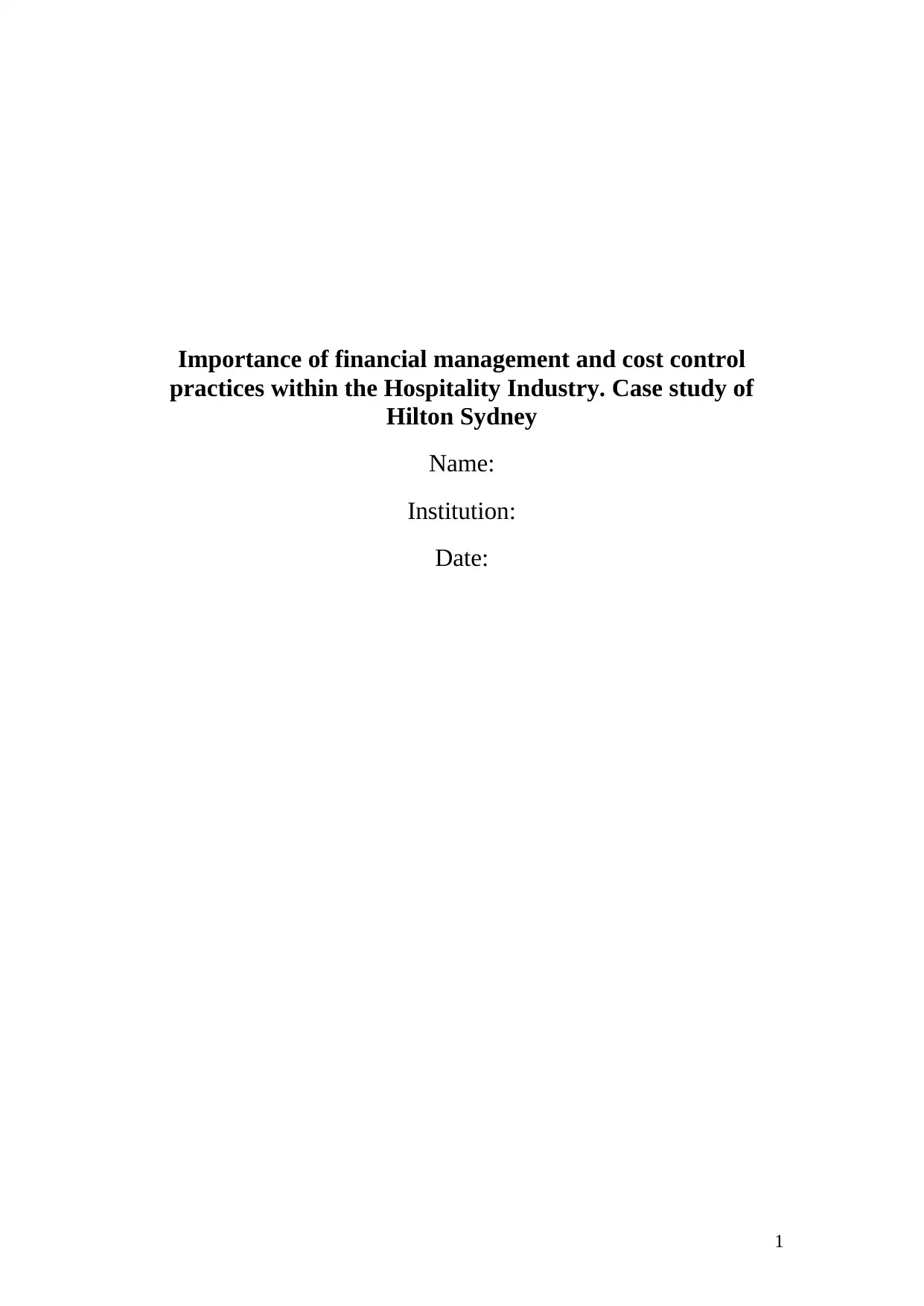
Importance of financial management and cost control
practices within the Hospitality Industry. Case study of
Hilton Sydney
Name:
Institution:
Date:
1
practices within the Hospitality Industry. Case study of
Hilton Sydney
Name:
Institution:
Date:
1
Paraphrase This Document
Need a fresh take? Get an instant paraphrase of this document with our AI Paraphraser
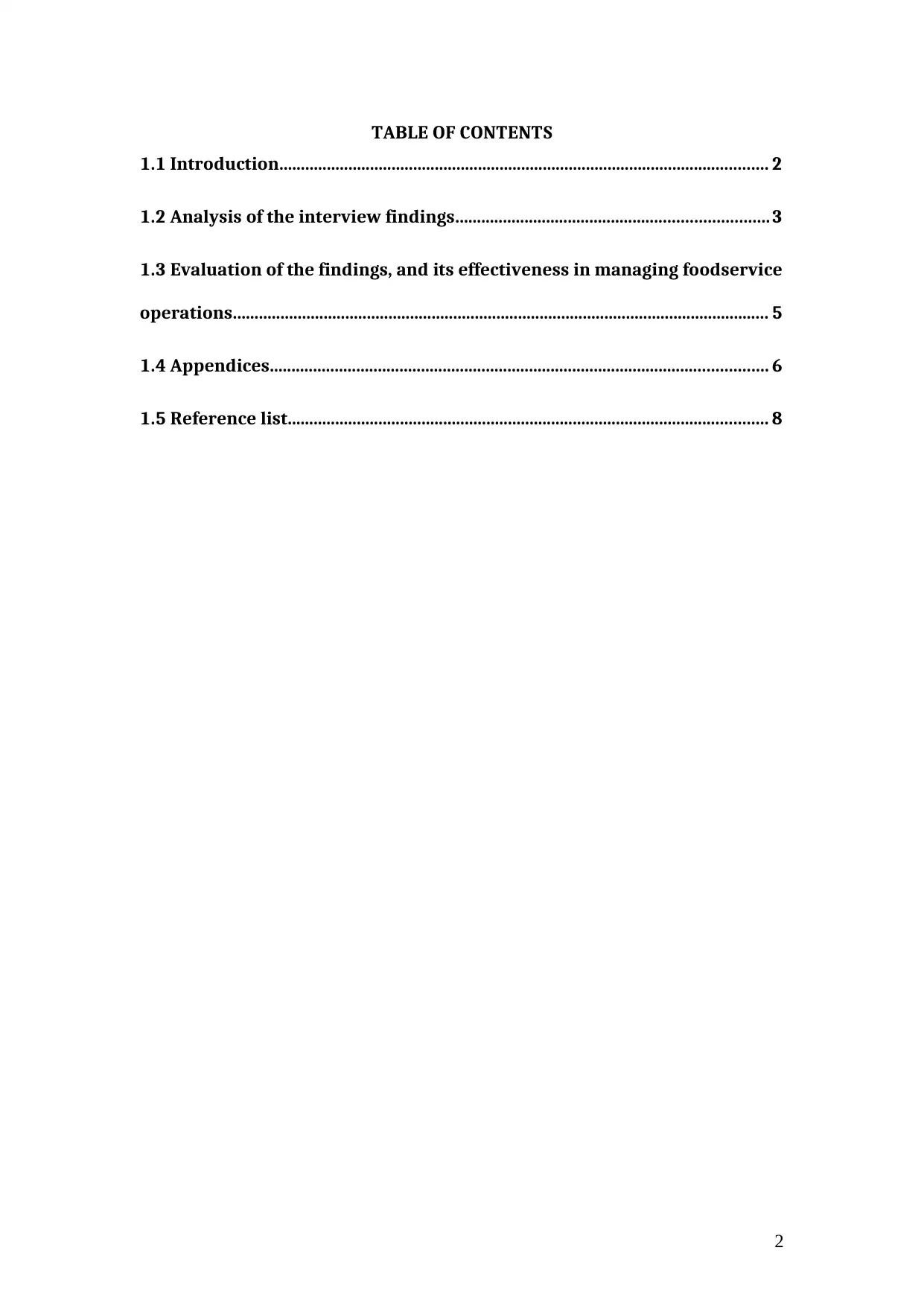
TABLE OF CONTENTS
1.1 Introduction................................................................................................................. 2
1.2 Analysis of the interview findings........................................................................3
1.3 Evaluation of the findings, and its effectiveness in managing foodservice
operations............................................................................................................................ 5
1.4 Appendices................................................................................................................... 6
1.5 Reference list............................................................................................................... 8
2
1.1 Introduction................................................................................................................. 2
1.2 Analysis of the interview findings........................................................................3
1.3 Evaluation of the findings, and its effectiveness in managing foodservice
operations............................................................................................................................ 5
1.4 Appendices................................................................................................................... 6
1.5 Reference list............................................................................................................... 8
2
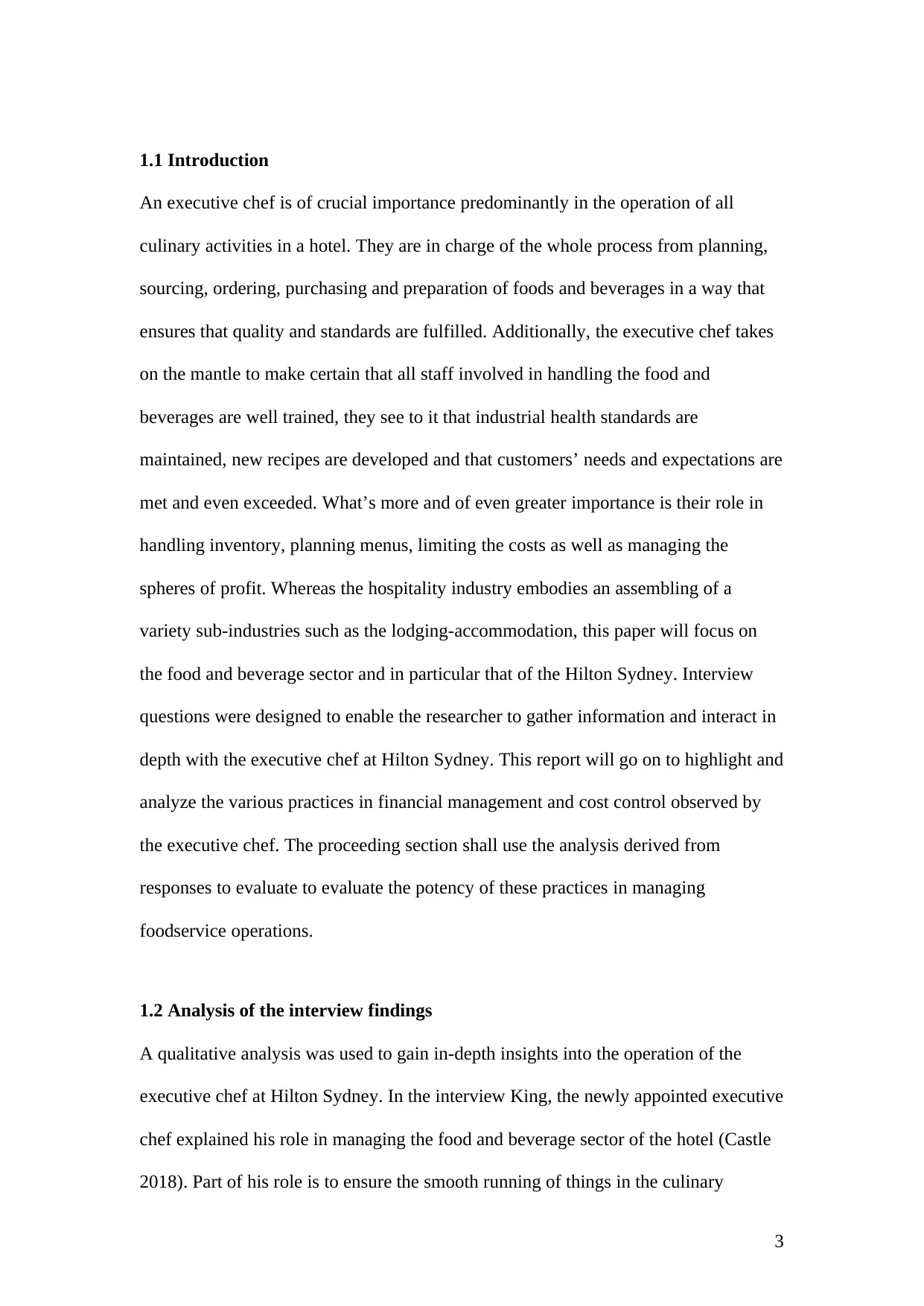
1.1 Introduction
An executive chef is of crucial importance predominantly in the operation of all
culinary activities in a hotel. They are in charge of the whole process from planning,
sourcing, ordering, purchasing and preparation of foods and beverages in a way that
ensures that quality and standards are fulfilled. Additionally, the executive chef takes
on the mantle to make certain that all staff involved in handling the food and
beverages are well trained, they see to it that industrial health standards are
maintained, new recipes are developed and that customers’ needs and expectations are
met and even exceeded. What’s more and of even greater importance is their role in
handling inventory, planning menus, limiting the costs as well as managing the
spheres of profit. Whereas the hospitality industry embodies an assembling of a
variety sub-industries such as the lodging-accommodation, this paper will focus on
the food and beverage sector and in particular that of the Hilton Sydney. Interview
questions were designed to enable the researcher to gather information and interact in
depth with the executive chef at Hilton Sydney. This report will go on to highlight and
analyze the various practices in financial management and cost control observed by
the executive chef. The proceeding section shall use the analysis derived from
responses to evaluate to evaluate the potency of these practices in managing
foodservice operations.
1.2 Analysis of the interview findings
A qualitative analysis was used to gain in-depth insights into the operation of the
executive chef at Hilton Sydney. In the interview King, the newly appointed executive
chef explained his role in managing the food and beverage sector of the hotel (Castle
2018). Part of his role is to ensure the smooth running of things in the culinary
3
An executive chef is of crucial importance predominantly in the operation of all
culinary activities in a hotel. They are in charge of the whole process from planning,
sourcing, ordering, purchasing and preparation of foods and beverages in a way that
ensures that quality and standards are fulfilled. Additionally, the executive chef takes
on the mantle to make certain that all staff involved in handling the food and
beverages are well trained, they see to it that industrial health standards are
maintained, new recipes are developed and that customers’ needs and expectations are
met and even exceeded. What’s more and of even greater importance is their role in
handling inventory, planning menus, limiting the costs as well as managing the
spheres of profit. Whereas the hospitality industry embodies an assembling of a
variety sub-industries such as the lodging-accommodation, this paper will focus on
the food and beverage sector and in particular that of the Hilton Sydney. Interview
questions were designed to enable the researcher to gather information and interact in
depth with the executive chef at Hilton Sydney. This report will go on to highlight and
analyze the various practices in financial management and cost control observed by
the executive chef. The proceeding section shall use the analysis derived from
responses to evaluate to evaluate the potency of these practices in managing
foodservice operations.
1.2 Analysis of the interview findings
A qualitative analysis was used to gain in-depth insights into the operation of the
executive chef at Hilton Sydney. In the interview King, the newly appointed executive
chef explained his role in managing the food and beverage sector of the hotel (Castle
2018). Part of his role is to ensure the smooth running of things in the culinary
3
You're viewing a preview
Unlock full access by subscribing today!
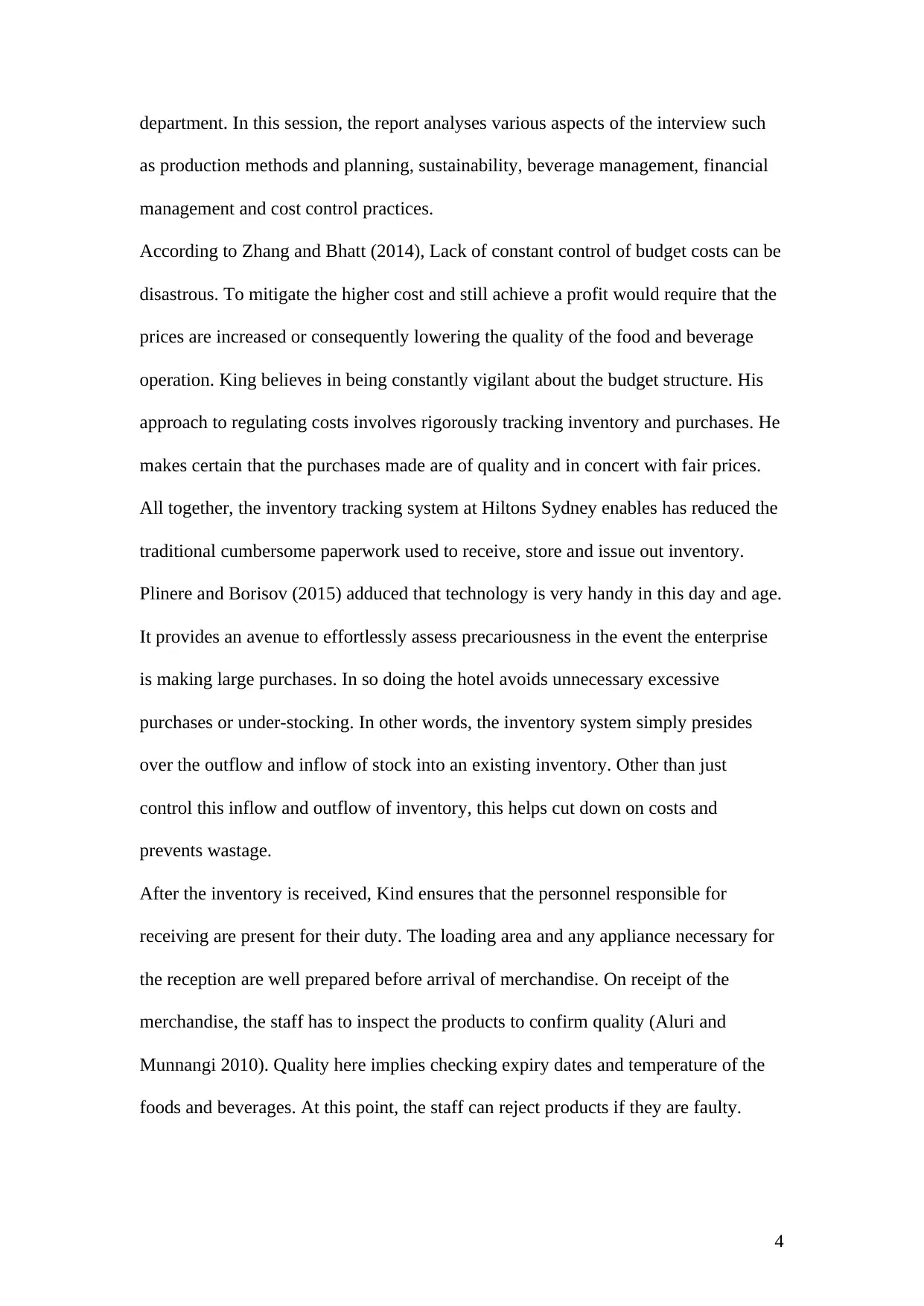
department. In this session, the report analyses various aspects of the interview such
as production methods and planning, sustainability, beverage management, financial
management and cost control practices.
According to Zhang and Bhatt (2014), Lack of constant control of budget costs can be
disastrous. To mitigate the higher cost and still achieve a profit would require that the
prices are increased or consequently lowering the quality of the food and beverage
operation. King believes in being constantly vigilant about the budget structure. His
approach to regulating costs involves rigorously tracking inventory and purchases. He
makes certain that the purchases made are of quality and in concert with fair prices.
All together, the inventory tracking system at Hiltons Sydney enables has reduced the
traditional cumbersome paperwork used to receive, store and issue out inventory.
Plinere and Borisov (2015) adduced that technology is very handy in this day and age.
It provides an avenue to effortlessly assess precariousness in the event the enterprise
is making large purchases. In so doing the hotel avoids unnecessary excessive
purchases or under-stocking. In other words, the inventory system simply presides
over the outflow and inflow of stock into an existing inventory. Other than just
control this inflow and outflow of inventory, this helps cut down on costs and
prevents wastage.
After the inventory is received, Kind ensures that the personnel responsible for
receiving are present for their duty. The loading area and any appliance necessary for
the reception are well prepared before arrival of merchandise. On receipt of the
merchandise, the staff has to inspect the products to confirm quality (Aluri and
Munnangi 2010). Quality here implies checking expiry dates and temperature of the
foods and beverages. At this point, the staff can reject products if they are faulty.
4
as production methods and planning, sustainability, beverage management, financial
management and cost control practices.
According to Zhang and Bhatt (2014), Lack of constant control of budget costs can be
disastrous. To mitigate the higher cost and still achieve a profit would require that the
prices are increased or consequently lowering the quality of the food and beverage
operation. King believes in being constantly vigilant about the budget structure. His
approach to regulating costs involves rigorously tracking inventory and purchases. He
makes certain that the purchases made are of quality and in concert with fair prices.
All together, the inventory tracking system at Hiltons Sydney enables has reduced the
traditional cumbersome paperwork used to receive, store and issue out inventory.
Plinere and Borisov (2015) adduced that technology is very handy in this day and age.
It provides an avenue to effortlessly assess precariousness in the event the enterprise
is making large purchases. In so doing the hotel avoids unnecessary excessive
purchases or under-stocking. In other words, the inventory system simply presides
over the outflow and inflow of stock into an existing inventory. Other than just
control this inflow and outflow of inventory, this helps cut down on costs and
prevents wastage.
After the inventory is received, Kind ensures that the personnel responsible for
receiving are present for their duty. The loading area and any appliance necessary for
the reception are well prepared before arrival of merchandise. On receipt of the
merchandise, the staff has to inspect the products to confirm quality (Aluri and
Munnangi 2010). Quality here implies checking expiry dates and temperature of the
foods and beverages. At this point, the staff can reject products if they are faulty.
4
Paraphrase This Document
Need a fresh take? Get an instant paraphrase of this document with our AI Paraphraser
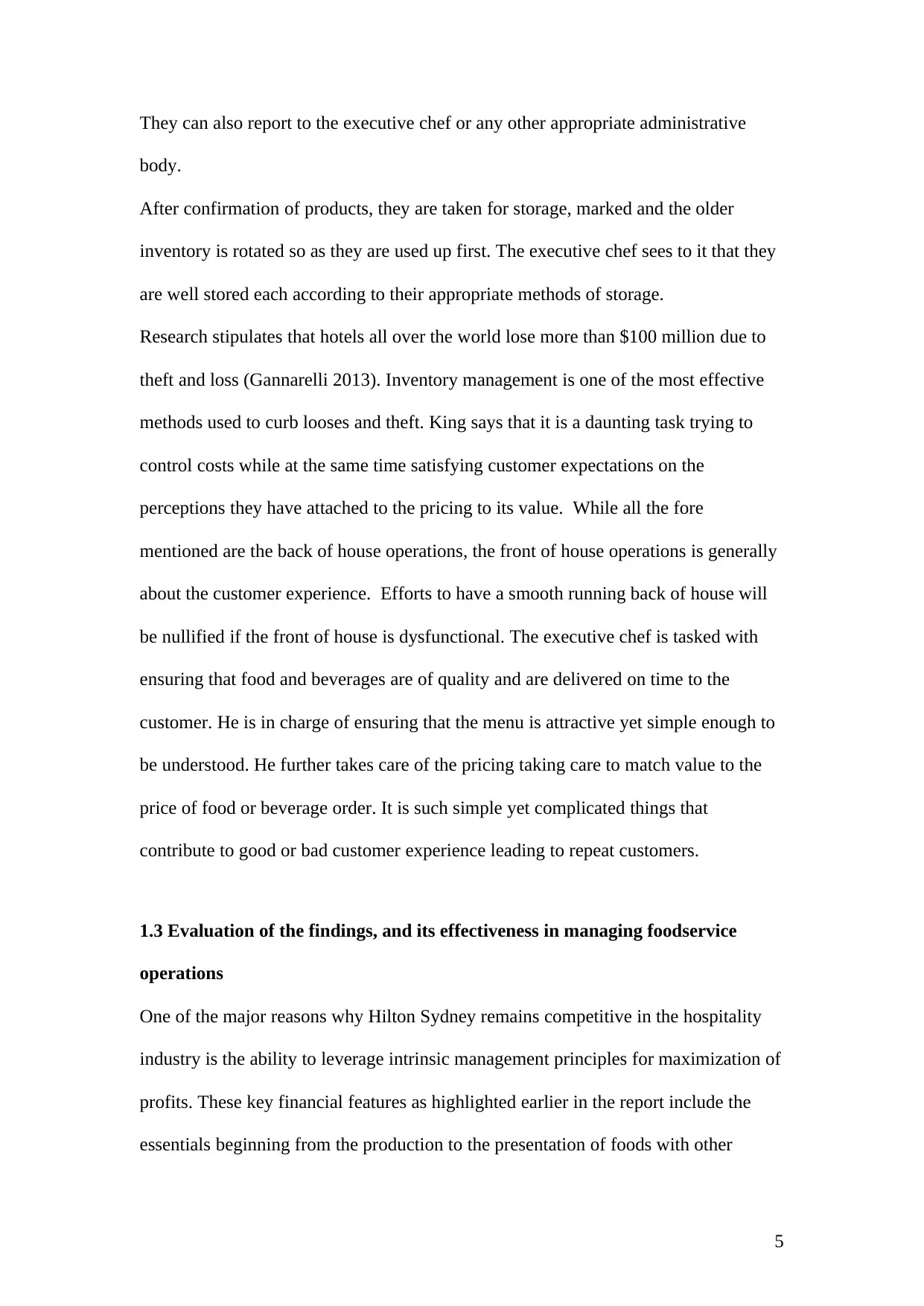
They can also report to the executive chef or any other appropriate administrative
body.
After confirmation of products, they are taken for storage, marked and the older
inventory is rotated so as they are used up first. The executive chef sees to it that they
are well stored each according to their appropriate methods of storage.
Research stipulates that hotels all over the world lose more than $100 million due to
theft and loss (Gannarelli 2013). Inventory management is one of the most effective
methods used to curb looses and theft. King says that it is a daunting task trying to
control costs while at the same time satisfying customer expectations on the
perceptions they have attached to the pricing to its value. While all the fore
mentioned are the back of house operations, the front of house operations is generally
about the customer experience. Efforts to have a smooth running back of house will
be nullified if the front of house is dysfunctional. The executive chef is tasked with
ensuring that food and beverages are of quality and are delivered on time to the
customer. He is in charge of ensuring that the menu is attractive yet simple enough to
be understood. He further takes care of the pricing taking care to match value to the
price of food or beverage order. It is such simple yet complicated things that
contribute to good or bad customer experience leading to repeat customers.
1.3 Evaluation of the findings, and its effectiveness in managing foodservice
operations
One of the major reasons why Hilton Sydney remains competitive in the hospitality
industry is the ability to leverage intrinsic management principles for maximization of
profits. These key financial features as highlighted earlier in the report include the
essentials beginning from the production to the presentation of foods with other
5
body.
After confirmation of products, they are taken for storage, marked and the older
inventory is rotated so as they are used up first. The executive chef sees to it that they
are well stored each according to their appropriate methods of storage.
Research stipulates that hotels all over the world lose more than $100 million due to
theft and loss (Gannarelli 2013). Inventory management is one of the most effective
methods used to curb looses and theft. King says that it is a daunting task trying to
control costs while at the same time satisfying customer expectations on the
perceptions they have attached to the pricing to its value. While all the fore
mentioned are the back of house operations, the front of house operations is generally
about the customer experience. Efforts to have a smooth running back of house will
be nullified if the front of house is dysfunctional. The executive chef is tasked with
ensuring that food and beverages are of quality and are delivered on time to the
customer. He is in charge of ensuring that the menu is attractive yet simple enough to
be understood. He further takes care of the pricing taking care to match value to the
price of food or beverage order. It is such simple yet complicated things that
contribute to good or bad customer experience leading to repeat customers.
1.3 Evaluation of the findings, and its effectiveness in managing foodservice
operations
One of the major reasons why Hilton Sydney remains competitive in the hospitality
industry is the ability to leverage intrinsic management principles for maximization of
profits. These key financial features as highlighted earlier in the report include the
essentials beginning from the production to the presentation of foods with other
5
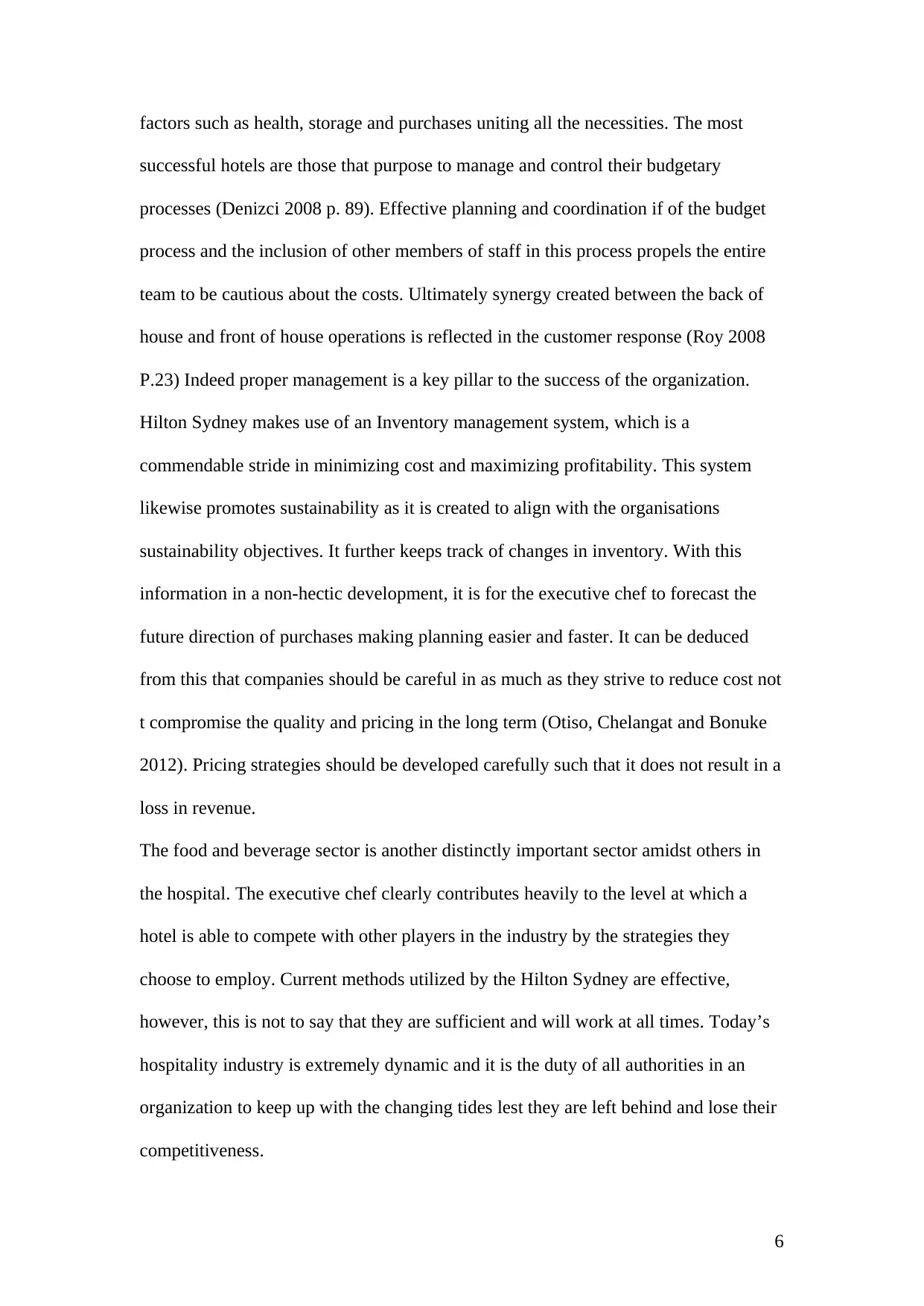
factors such as health, storage and purchases uniting all the necessities. The most
successful hotels are those that purpose to manage and control their budgetary
processes (Denizci 2008 p. 89). Effective planning and coordination if of the budget
process and the inclusion of other members of staff in this process propels the entire
team to be cautious about the costs. Ultimately synergy created between the back of
house and front of house operations is reflected in the customer response (Roy 2008
P.23) Indeed proper management is a key pillar to the success of the organization.
Hilton Sydney makes use of an Inventory management system, which is a
commendable stride in minimizing cost and maximizing profitability. This system
likewise promotes sustainability as it is created to align with the organisations
sustainability objectives. It further keeps track of changes in inventory. With this
information in a non-hectic development, it is for the executive chef to forecast the
future direction of purchases making planning easier and faster. It can be deduced
from this that companies should be careful in as much as they strive to reduce cost not
t compromise the quality and pricing in the long term (Otiso, Chelangat and Bonuke
2012). Pricing strategies should be developed carefully such that it does not result in a
loss in revenue.
The food and beverage sector is another distinctly important sector amidst others in
the hospital. The executive chef clearly contributes heavily to the level at which a
hotel is able to compete with other players in the industry by the strategies they
choose to employ. Current methods utilized by the Hilton Sydney are effective,
however, this is not to say that they are sufficient and will work at all times. Today’s
hospitality industry is extremely dynamic and it is the duty of all authorities in an
organization to keep up with the changing tides lest they are left behind and lose their
competitiveness.
6
successful hotels are those that purpose to manage and control their budgetary
processes (Denizci 2008 p. 89). Effective planning and coordination if of the budget
process and the inclusion of other members of staff in this process propels the entire
team to be cautious about the costs. Ultimately synergy created between the back of
house and front of house operations is reflected in the customer response (Roy 2008
P.23) Indeed proper management is a key pillar to the success of the organization.
Hilton Sydney makes use of an Inventory management system, which is a
commendable stride in minimizing cost and maximizing profitability. This system
likewise promotes sustainability as it is created to align with the organisations
sustainability objectives. It further keeps track of changes in inventory. With this
information in a non-hectic development, it is for the executive chef to forecast the
future direction of purchases making planning easier and faster. It can be deduced
from this that companies should be careful in as much as they strive to reduce cost not
t compromise the quality and pricing in the long term (Otiso, Chelangat and Bonuke
2012). Pricing strategies should be developed carefully such that it does not result in a
loss in revenue.
The food and beverage sector is another distinctly important sector amidst others in
the hospital. The executive chef clearly contributes heavily to the level at which a
hotel is able to compete with other players in the industry by the strategies they
choose to employ. Current methods utilized by the Hilton Sydney are effective,
however, this is not to say that they are sufficient and will work at all times. Today’s
hospitality industry is extremely dynamic and it is the duty of all authorities in an
organization to keep up with the changing tides lest they are left behind and lose their
competitiveness.
6
You're viewing a preview
Unlock full access by subscribing today!
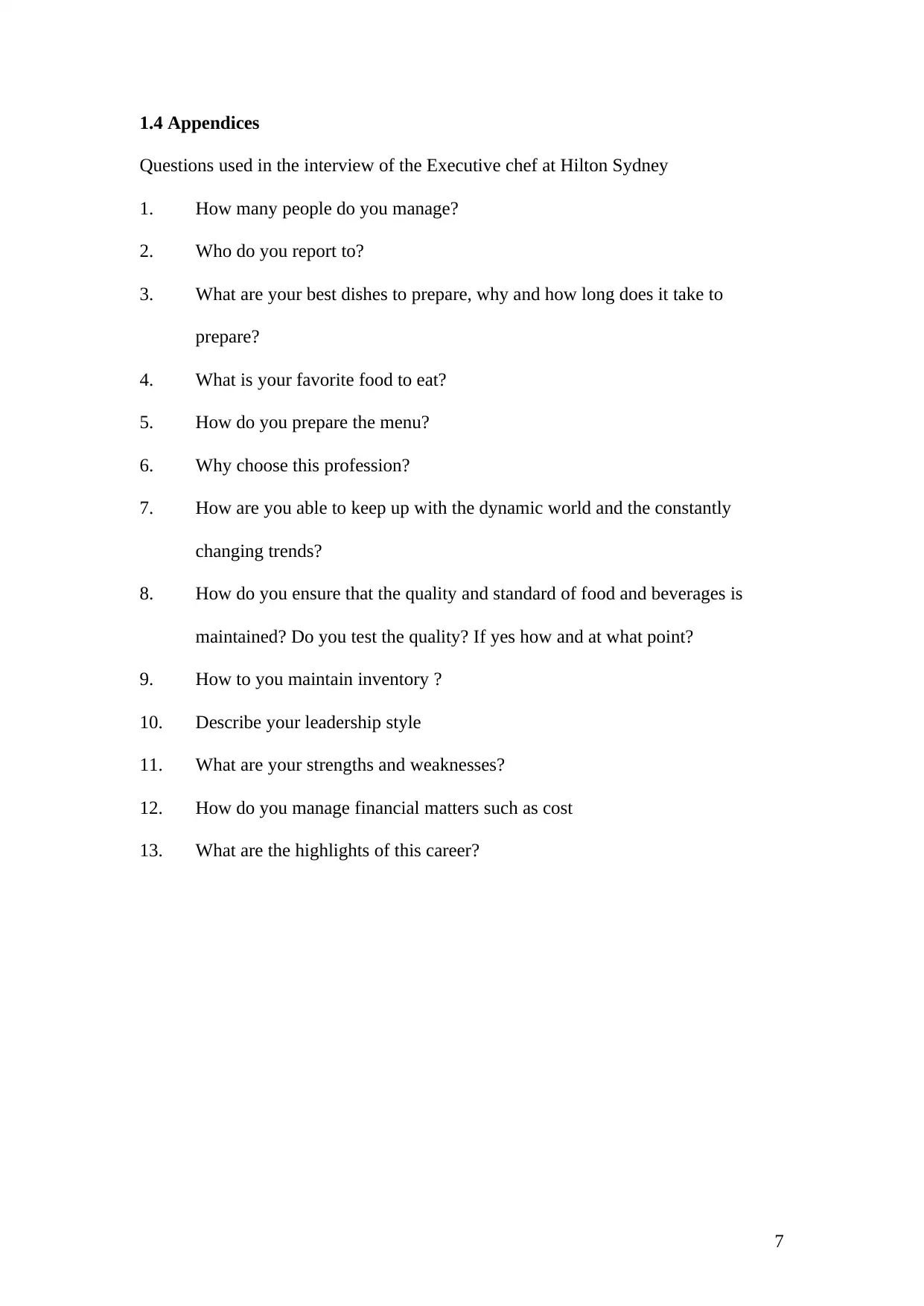
1.4 Appendices
Questions used in the interview of the Executive chef at Hilton Sydney
1. How many people do you manage?
2. Who do you report to?
3. What are your best dishes to prepare, why and how long does it take to
prepare?
4. What is your favorite food to eat?
5. How do you prepare the menu?
6. Why choose this profession?
7. How are you able to keep up with the dynamic world and the constantly
changing trends?
8. How do you ensure that the quality and standard of food and beverages is
maintained? Do you test the quality? If yes how and at what point?
9. How to you maintain inventory ?
10. Describe your leadership style
11. What are your strengths and weaknesses?
12. How do you manage financial matters such as cost
13. What are the highlights of this career?
7
Questions used in the interview of the Executive chef at Hilton Sydney
1. How many people do you manage?
2. Who do you report to?
3. What are your best dishes to prepare, why and how long does it take to
prepare?
4. What is your favorite food to eat?
5. How do you prepare the menu?
6. Why choose this profession?
7. How are you able to keep up with the dynamic world and the constantly
changing trends?
8. How do you ensure that the quality and standard of food and beverages is
maintained? Do you test the quality? If yes how and at what point?
9. How to you maintain inventory ?
10. Describe your leadership style
11. What are your strengths and weaknesses?
12. How do you manage financial matters such as cost
13. What are the highlights of this career?
7
Paraphrase This Document
Need a fresh take? Get an instant paraphrase of this document with our AI Paraphraser
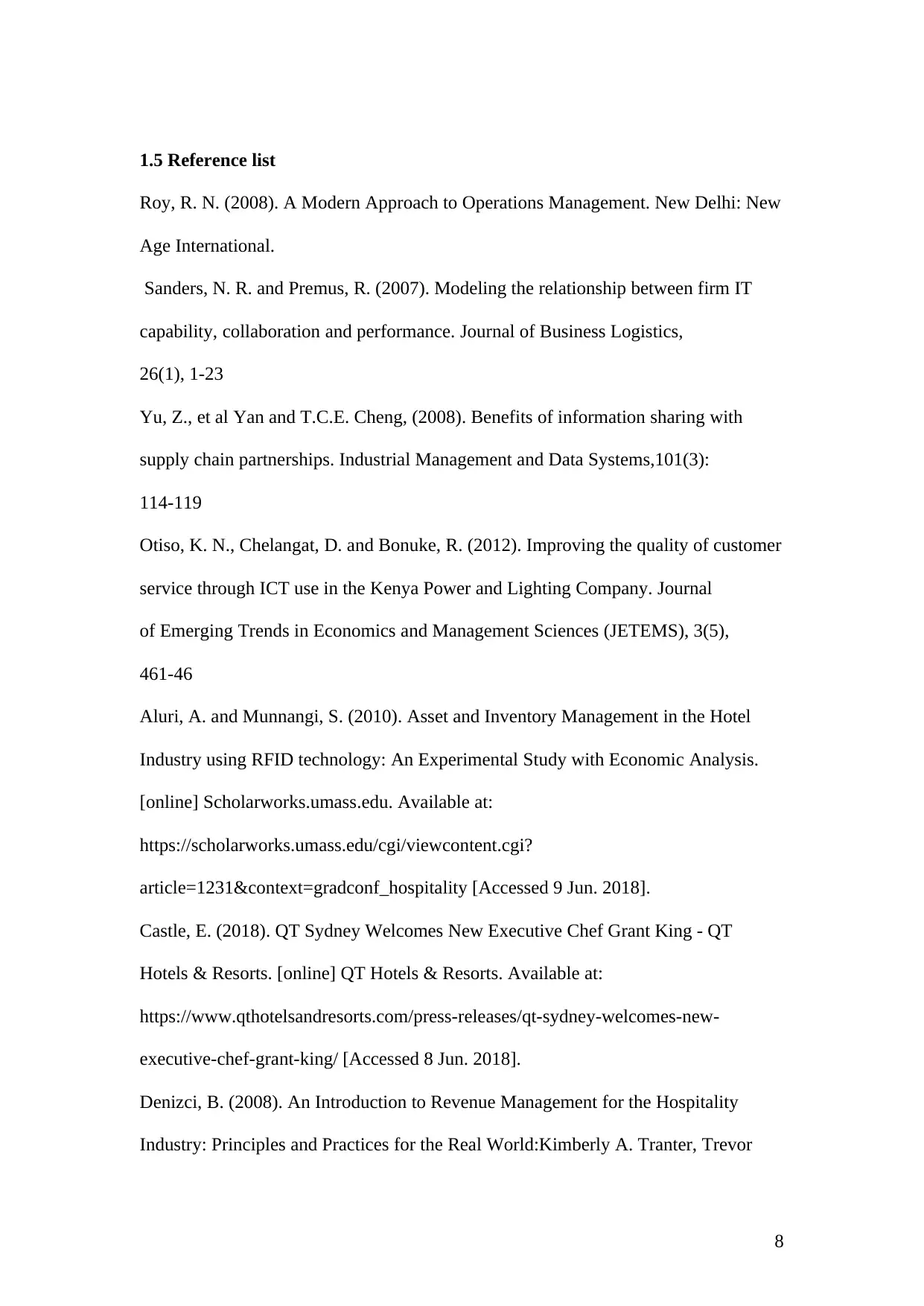
1.5 Reference list
Roy, R. N. (2008). A Modern Approach to Operations Management. New Delhi: New
Age International.
Sanders, N. R. and Premus, R. (2007). Modeling the relationship between firm IT
capability, collaboration and performance. Journal of Business Logistics,
26(1), 1-23
Yu, Z., et al Yan and T.C.E. Cheng, (2008). Benefits of information sharing with
supply chain partnerships. Industrial Management and Data Systems,101(3):
114-119
Otiso, K. N., Chelangat, D. and Bonuke, R. (2012). Improving the quality of customer
service through ICT use in the Kenya Power and Lighting Company. Journal
of Emerging Trends in Economics and Management Sciences (JETEMS), 3(5),
461-46
Aluri, A. and Munnangi, S. (2010). Asset and Inventory Management in the Hotel
Industry using RFID technology: An Experimental Study with Economic Analysis.
[online] Scholarworks.umass.edu. Available at:
https://scholarworks.umass.edu/cgi/viewcontent.cgi?
article=1231&context=gradconf_hospitality [Accessed 9 Jun. 2018].
Castle, E. (2018). QT Sydney Welcomes New Executive Chef Grant King - QT
Hotels & Resorts. [online] QT Hotels & Resorts. Available at:
https://www.qthotelsandresorts.com/press-releases/qt-sydney-welcomes-new-
executive-chef-grant-king/ [Accessed 8 Jun. 2018].
Denizci, B. (2008). An Introduction to Revenue Management for the Hospitality
Industry: Principles and Practices for the Real World:Kimberly A. Tranter, Trevor
8
Roy, R. N. (2008). A Modern Approach to Operations Management. New Delhi: New
Age International.
Sanders, N. R. and Premus, R. (2007). Modeling the relationship between firm IT
capability, collaboration and performance. Journal of Business Logistics,
26(1), 1-23
Yu, Z., et al Yan and T.C.E. Cheng, (2008). Benefits of information sharing with
supply chain partnerships. Industrial Management and Data Systems,101(3):
114-119
Otiso, K. N., Chelangat, D. and Bonuke, R. (2012). Improving the quality of customer
service through ICT use in the Kenya Power and Lighting Company. Journal
of Emerging Trends in Economics and Management Sciences (JETEMS), 3(5),
461-46
Aluri, A. and Munnangi, S. (2010). Asset and Inventory Management in the Hotel
Industry using RFID technology: An Experimental Study with Economic Analysis.
[online] Scholarworks.umass.edu. Available at:
https://scholarworks.umass.edu/cgi/viewcontent.cgi?
article=1231&context=gradconf_hospitality [Accessed 9 Jun. 2018].
Castle, E. (2018). QT Sydney Welcomes New Executive Chef Grant King - QT
Hotels & Resorts. [online] QT Hotels & Resorts. Available at:
https://www.qthotelsandresorts.com/press-releases/qt-sydney-welcomes-new-
executive-chef-grant-king/ [Accessed 8 Jun. 2018].
Denizci, B. (2008). An Introduction to Revenue Management for the Hospitality
Industry: Principles and Practices for the Real World:Kimberly A. Tranter, Trevor
8
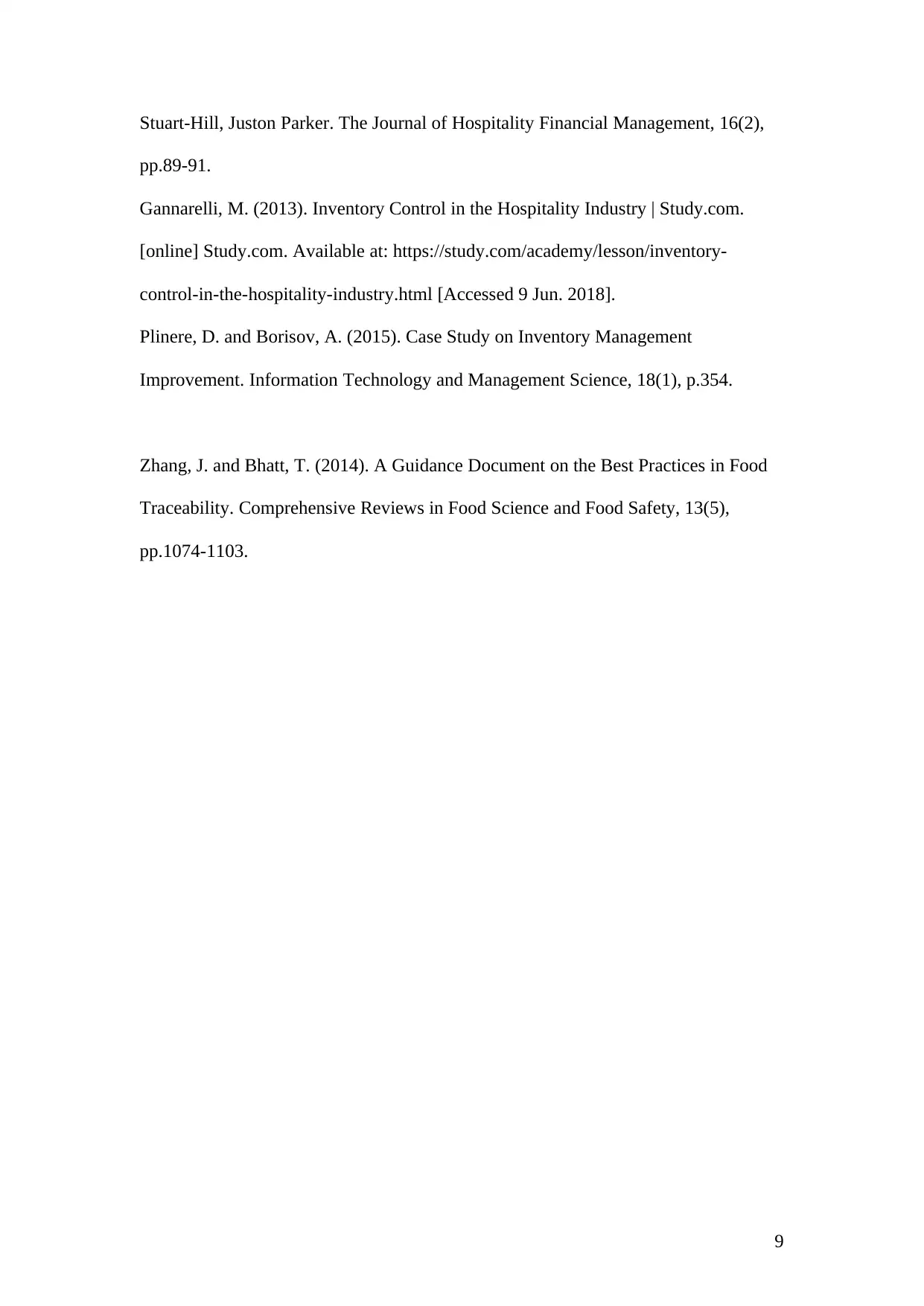
Stuart-Hill, Juston Parker. The Journal of Hospitality Financial Management, 16(2),
pp.89-91.
Gannarelli, M. (2013). Inventory Control in the Hospitality Industry | Study.com.
[online] Study.com. Available at: https://study.com/academy/lesson/inventory-
control-in-the-hospitality-industry.html [Accessed 9 Jun. 2018].
Plinere, D. and Borisov, A. (2015). Case Study on Inventory Management
Improvement. Information Technology and Management Science, 18(1), p.354.
Zhang, J. and Bhatt, T. (2014). A Guidance Document on the Best Practices in Food
Traceability. Comprehensive Reviews in Food Science and Food Safety, 13(5),
pp.1074-1103.
9
pp.89-91.
Gannarelli, M. (2013). Inventory Control in the Hospitality Industry | Study.com.
[online] Study.com. Available at: https://study.com/academy/lesson/inventory-
control-in-the-hospitality-industry.html [Accessed 9 Jun. 2018].
Plinere, D. and Borisov, A. (2015). Case Study on Inventory Management
Improvement. Information Technology and Management Science, 18(1), p.354.
Zhang, J. and Bhatt, T. (2014). A Guidance Document on the Best Practices in Food
Traceability. Comprehensive Reviews in Food Science and Food Safety, 13(5),
pp.1074-1103.
9
You're viewing a preview
Unlock full access by subscribing today!
1 out of 9
Related Documents
Your All-in-One AI-Powered Toolkit for Academic Success.
+13062052269
info@desklib.com
Available 24*7 on WhatsApp / Email
![[object Object]](/_next/static/media/star-bottom.7253800d.svg)
Unlock your academic potential
© 2024 | Zucol Services PVT LTD | All rights reserved.





